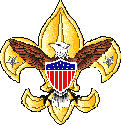| MERIT BADGES |
|
|
|
|
| Note: Eagle Required are in Italics |
"A"
American
Business
American Culture
American Heritage
American Labor
Animal Science
Archaeology
Archery
Architecture
Art
Astronomy
Athletics
Atomic Energy
Auto Mechanics
Aviation
"B"
Backpacking
Basketry
Bird Study
Bugling
"C"
Camping
Canoeing
Chemistry
Cinematography
Citizenship
Community*
Citizenship Nation*
Citizenship World*
Climbing
Coin Collecting
Collections
Communications*
Computers
Cooking
Crime Prevention
Cycling*
"D"
Dentistry
Disability Awareness
Dog Care
Drafting
"E"
Electricity
Electronics
Emergency
Preparedness**
Energy
Engineering
Entrepreneurship
Environmental
Science*
"F"
Family Life*
Farm Mechanics
Fingerprinting
Fire Safety
First Aid*
Fish & Wildlife Mgmt.
Fishing
Fly Fishing
Forestry
"G"
Gardening
Genealogy
Geology
Golf
Graphic Arts
"H"
Hiking
Home Repairs
Horsemanship
"I"
Indian Lore
Insect Studies
"J"
Journalism
"K"
"L"
Landscape Architecture
Law
Leatherwork
Lifesaving**
"M"
Mammal Study
Medicine
Metalwork
Model Design & Building
Motorboating
Music
"N"
Nature
"O"
Oceanography
Orienteering
"P"
Painting
Personal Fitness**
Personal Management*
Pets
Photography
Pioneering
Plant Science
Plumbing
Pottery
Public Health
Public Speaking
Pulp and Paper
"Q"
"R"
Radio
Railroading
Reading
Reptile & Amphibian Study
Rifle Shooting
Rowing
"S"
Safety
Salesmanship
Scholarship
Sculpture
Shotgun Shooting
Skating
Skiing
Small Boat Sailing
Soil & Water
Conservation
Space Exploration
Sports**
Stamp Collecting
Surveying
Swimming**
"T"
Textile
Theatre
Traffic Safety
Truck Transportation
"U"
"V"
Veterinary Medicine
"W"
Water Skiing
Weather
Whitewater
Wilderness Survival
Wood Carving
Woodwork
"X"
"Y"
"Z"
 Railroading RailroadingRequirements 1993 |
- Do TWO of the following:
- Know the name and track gauge for four model railroad gauges. Show the correct way to clean and lubricate model train equipment.
- Draw to scale the layout of your own model railroad or one that could be built in your home. Have a point-to-point or loop with different routings. Include a turnaround, a terminal, or a yard and a siding.
- Alone or with others, build a model railroad layout to include ballast and scenery. Make connections from power supply to the track and accessories, if any.
- Build a scale model of a locomotive (with or without power) or make two cars. (Kits with extra detail may be used.)
- Draw scale plans and build two accessories.
- Do the following:
- Explain how real electric and diesel locomotives develop power.
- Identify by model or picture six different kinds of railroad cars.
- Show two basic signals used either by color or configuration. Explain the meaning of five whistle signals. Describe an emergency way to signal a train to stop.
- Do ONE of the following:
- Name four departments of a railroad company. Describe what each does.
- Name and explain ten jobs in railroading. Tell which job interests you most. Tell why.
- Explain six rules of safety to use aboard trains; on platforms; at crossings; and around bridges, yards, and tunnels. Explain the use and function of the "EOTD" or "FRED" now used in place of cabooses.
- Explain the use of a timetable by making a written plan for a trip by rail between two cities at least 500 miles apart. List the times of departure and of arrival at your destination, the number of the train, and the service you want.
- Do ONE of the following:
- Visit a railroad museum or an operating model railroad and explain what you saw.
- View a video showing the operation of a railroad, such as This Is My Railroad or Association of American Railroads by Pentrax.
- Plan and take a rail trip of at least 25 miles. Buy your own ticket. Read the timetables and footnotes correctly.
- Name three types of modern freight trains and explain why they are more efficient than mixed freights.
|
||||||
Last Update May 15, 2023

.jpg)
